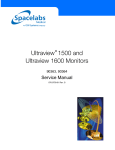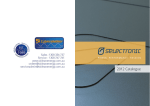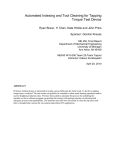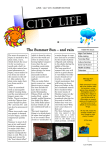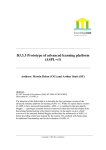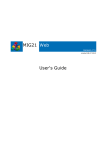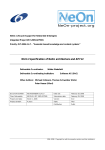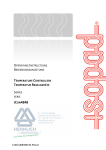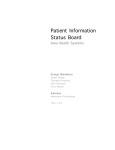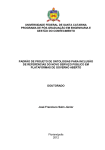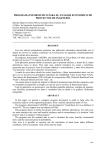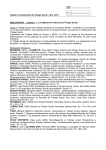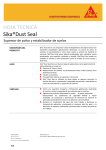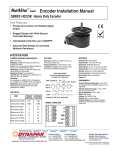Download Link - NeOn Project
Transcript
NeOn-project.org
NeOn: Lifecycle Support for Networked Ontologies
Integrated Project (IST-2005-027595)
Priority: IST-2004-2.4.7 — “Semantic-based knowledge and content systems”
D1.4.3 Cupboard—Supporting Ontology Reuse by
Combining a Semantic Web Gateway, Ontology Registry
and Open Ratings Systems
Deliverable Co-ordinator:
Holger Lewen
Deliverable Co-ordinating Institution:
Universität Karlsruhe (TH)
Other Authors: Mathieu d’Aquin (OU), Jérôme Eurenat (INRIA), Chan Le Duc
(INRIA), Raúl Palma (UPM)
In this deliverable, we present the Cupboard system for ontology publishing, sharing and reuse.
This system is intended to support both ontology engineers and ontology users/practitioners.
For the developers of ontologies, it offers a complete infrastructure to host their ontologies in
online ontology spaces, providing mechanisms to describe, manage and effectively exploit these
ontologies (through APIs). Furthermore, these ontologies are then exposed to the community,
providing users with a complete, friendly environment to find, assess and reuse ontologies.
Document Identifier:
Class Deliverable:
Project start date
Project duration:
NEON/2009/D1.4.3/v1.0
NEON EU-IST-2005-027595
March 1, 2006
4 years
Date due:
Submission date:
Version:
State:
Distribution:
February 28, 2009
February 28, 2009
v1.0
Final
Public
c Copyright lies with the respective authors and their institutions.
2006–2009 Page 2 of 29
NeOn Integrated Project EU-IST-027595
NeOn Consortium
This document is part of the NeOn research project funded by the IST Programme of the Commission of the
European Communities by the grant number IST-2005-027595. The following partners are involved in the
project:
Open University (OU) – Coordinator
Knowledge Media Institute – KMi
Berrill Building, Walton Hall
Milton Keynes, MK7 6AA
United Kingdom
Contact person: Martin Dzbor, Enrico Motta
E-mail address: {m.dzbor, e.motta}@open.ac.uk
Universidad Politécnica de Madrid (UPM)
Campus de Montegancedo
28660 Boadilla del Monte
Spain
Contact person: Asunción Gómez Pérez
E-mail address: [email protected]
Intelligent Software Components S.A. (ISOCO)
Calle de Pedro de Valdivia 10
28006 Madrid
Spain
Contact person: Jesús Contreras
E-mail address: [email protected]
Institut National de Recherche en Informatique
et en Automatique (INRIA)
ZIRST – 665 avenue de l’Europe
Montbonnot Saint Martin
38334 Saint-Ismier, France
Contact person: Jérôme Euzenat
E-mail address: [email protected]
Universität Kolenz-Landau (UKO-LD)
Universitätsstrasse 1
56070 Koblenz
Germany
Contact person: Steffen Staab
E-mail address: [email protected]
Ontoprise GmbH. (ONTO)
Amalienbadstr. 36
(Raumfabrik 29)
76227 Karlsruhe
Germany
Contact person: Jürgen Angele
E-mail address: [email protected]
Atos Origin S.A. (ATOS)
Calle de Albarracín, 25
28037 Madrid
Spain
Contact person: Tomás Pariente Lobo
E-mail address: [email protected]
Universität Karlsruhe – TH (UKARL)
Institut für Angewandte Informatik und Formale
Beschreibungsverfahren – AIFB
Englerstrasse 11
D-76128 Karlsruhe, Germany
Contact person: Peter Haase
E-mail address: [email protected]
Software AG (SAG)
Uhlandstrasse 12
64297 Darmstadt
Germany
Contact person: Walter Waterfeld
E-mail address: [email protected]
Institut ‘Jožef Stefan’ (JSI)
Jamova 39
SL–1000 Ljubljana
Slovenia
Contact person: Marko Grobelnik
E-mail address: [email protected]
University of Sheffield (USFD)
Dept. of Computer Science
Regent Court
211 Portobello street
S14DP Sheffield, United Kingdom
Contact person: Hamish Cunningham
E-mail address: [email protected]
Consiglio Nazionale delle Ricerche (CNR)
Institute of cognitive sciences and technologies
Via S. Marino della Battaglia
44 – 00185 Roma-Lazio Italy
Contact person: Aldo Gangemi
E-mail address: [email protected]
Food and Agriculture Organization
of the United Nations (FAO)
Viale delle Terme di Caracalla
00100 Rome
Italy
Contact person: Marta Iglesias
E-mail address: [email protected]
Laboratorios KIN, S.A. (KIN)
C/Ciudad de Granada, 123
08018 Barcelona
Spain
Contact person: Antonio López
E-mail address: [email protected]
D1.4.3 Cupboard—Supporting Ontology Reuse by Combining a Semantic Web Gateway, Ontology Registry and Open
Ratings Systems
Page 3 of 29
Work package participants
The following partners have taken an active part in the work leading to the elaboration of this document, even
if they might not have directly contributed to the writing of this document or its parts:
• OU
• INRIA
• UPM
Change Log
Version
0.1
0.2
0.3
Date
07-03-2008
07-14-2008
01-25-2009
Amended by
Holger Lewen
Jérôme Euzenat
Holger Lewen
0.4
02-12-2009
Mathieu d’Aquin
0.5
0.6
02-14-2009
02-18-2009
Raul Palma
Jérôme Euzenat
0.7
02-19-2009
Holger Lewen
0.8
0.9
1.0
02-20-2009
02-23-2009
03-20-2009
Mathieu d’Aquin
Holger Lewen
Holger Lewen
Changes
Skeleton of Deliverable created
Author added
Seeded document with ESWC Demo
Submission
Added the development plan chapter with
details of the integration of Watson, and
other things
Added content about Oyster integration
Added content about Alignment integration
Added content about TS-ORS integration
and user manual
Corrections
Compiled final version for internal review.
Addressed comments from the internal
review.
c Copyright lies with the respective authors and their institutions.
2006–2009 Page 4 of 29
NeOn Integrated Project EU-IST-027595
Executive Summary
In this deliverable, we present the Cupboard system for ontology publishing, sharing and reuse. This system is intended to support both ontology engineers and ontology users/practitioners. For the developers
of ontologies, it offers a complete infrastructure to host their ontologies in online ontology spaces, providing mechanisms to describe, manage and effectively exploit these ontologies (through APIs). Furthermore,
these ontologies are then exposed to the community, providing users with a complete, friendly environment
to find, assess and reuse ontologies. We furthermore describe the current state of implementation and the
plan for completing the rest. Also a user’s guide is provided to guide the users through the application.
D1.4.3 Cupboard—Supporting Ontology Reuse by Combining a Semantic Web Gateway, Ontology Registry and Open
Ratings Systems
Page 5 of 29
Contents
1 Introduction – What is Cupboard
7
2 The Cupboard System
8
2.1 Overview . . . . . . . . . . . . . . . . . . . . . . . . . . . . . . . . . . . . . . . . . . . . . .
8
2.2 Architecture . . . . . . . . . . . . . . . . . . . . . . . . . . . . . . . . . . . . . . . . . . . .
9
3 Development Plan
11
3.1 Details of the Current Implementation . . . . . . . . . . . . . . . . . . . . . . . . . . . . . . . 11
3.1.1 The Cupboard Core . . . . . . . . . . . . . . . . . . . . . . . . . . . . . . . . . . . . 11
3.1.2 Integration of Watson
. . . . . . . . . . . . . . . . . . . . . . . . . . . . . . . . . . . 12
3.1.3 Integration of Oyster . . . . . . . . . . . . . . . . . . . . . . . . . . . . . . . . . . . . 12
3.1.4 Integration of the TS-ORS review system . . . . . . . . . . . . . . . . . . . . . . . . . 13
3.2 Availability . . . . . . . . . . . . . . . . . . . . . . . . . . . . . . . . . . . . . . . . . . . . . 13
3.3 Scheduled Developments . . . . . . . . . . . . . . . . . . . . . . . . . . . . . . . . . . . . . 14
3.3.1 Integration of the Alignment Server (March 2009) . . . . . . . . . . . . . . . . . . . . . 14
3.3.2 Integration of advanced visualization mechanism (April 2009) . . . . . . . . . . . . . . 14
3.3.3 Federated API and NeOn Toolkit Plugins (May 2009) . . . . . . . . . . . . . . . . . . . 15
3.3.4 Distributed System (end 2009) . . . . . . . . . . . . . . . . . . . . . . . . . . . . . . . 15
3.4 Release Plan . . . . . . . . . . . . . . . . . . . . . . . . . . . . . . . . . . . . . . . . . . . . 15
4 Conclusion
17
5 Appendix
18
5.1 User Manual . . . . . . . . . . . . . . . . . . . . . . . . . . . . . . . . . . . . . . . . . . . . 18
5.1.1 Installation . . . . . . . . . . . . . . . . . . . . . . . . . . . . . . . . . . . . . . . . . 18
5.1.2 Getting started – Logging in . . . . . . . . . . . . . . . . . . . . . . . . . . . . . . . . 18
5.1.3 Ontology Space . . . . . . . . . . . . . . . . . . . . . . . . . . . . . . . . . . . . . . 19
5.1.4 Adding an ontology . . . . . . . . . . . . . . . . . . . . . . . . . . . . . . . . . . . . . 19
Bibliography
28
c Copyright lies with the respective authors and their institutions.
2006–2009 Page 6 of 29
NeOn Integrated Project EU-IST-027595
List of Figures
2.1 Screenshots of some components of the Cupboard Web interface. . . . . . . . . . . . . . . .
9
2.2 Cupboard’s architecture. . . . . . . . . . . . . . . . . . . . . . . . . . . . . . . . . . . . . . . 10
5.1 This welcome screen is currently displayed when surfing to the Cupboard website. . . . . . . . 18
5.2 The system accepts an OpenID as login-credential. . . . . . . . . . . . . . . . . . . . . . . . 19
5.3 The ontology space contains all ontologies added by the user. It also displays additional
metadata of the ontologies. . . . . . . . . . . . . . . . . . . . . . . . . . . . . . . . . . . . . 19
5.4 Using this form, ontologies can be added to the ontology space. . . . . . . . . . . . . . . . . . 20
5.5 Here the user can decide to adapt the namespace of the ontology. . . . . . . . . . . . . . . . 20
5.6 Metadata can be entered for the ontology.
. . . . . . . . . . . . . . . . . . . . . . . . . . . . 21
5.7 For certain metadata, entries can be selected from a drop-down list.
5.8 Here the metadata for an ontology is displayed.
. . . . . . . . . . . . . . 22
. . . . . . . . . . . . . . . . . . . . . . . . . 22
5.9 Using this form, the Cupboard system can be queried. . . . . . . . . . . . . . . . . . . . . . . 23
5.10 A result set for the query for “University”. . . . . . . . . . . . . . . . . . . . . . . . . . . . . . 23
5.11 A result set for the query for “University” within the specified ontology. . . . . . . . . . . . . . . 24
5.12 After clicking on the “+”, the results are extended to display additional information. . . . . . . . 24
5.13 The user can provide star ratings and explanations for these ratings for each of the five ontological properties. . . . . . . . . . . . . . . . . . . . . . . . . . . . . . . . . . . . . . . . . . 25
5.14 The reviews are presented broken down into the 5 properties. The most relevant review is
displayed first. By clicking on “I trust” or “I don’t trust”, trust or distrust statements are stored
in the databased and the web of trust is updated. . . . . . . . . . . . . . . . . . . . . . . . . . 26
5.15 The reviews are presented broken down into the 5 properties. The most relevant review is
displayed first, based on the general opinion of the users. . . . . . . . . . . . . . . . . . . . . 27
D1.4.3 Cupboard—Supporting Ontology Reuse by Combining a Semantic Web Gateway, Ontology Registry and Open
Ratings Systems
Page 7 of 29
Chapter 1
Introduction – What is Cupboard
In the recent years, there has been an ever-increasing amount of ontologies indexed by ontology search
engines such as Watson1 . Yet, even with so many ontologies now available to reuse, the tasks of finding,
assessing and effectively making use of existing ontologies remain difficult. We argue that the main factor
inhibiting ontology reuse relates to the lack of support for ontology practitioners to find, assess and exploit
existing ontologies, and incidentally to the lack of support for ontology engineers to effectively deploy and
expose their ontologies for use and reuse.
Ontology search engines provide a partial answer to this problem, as they support users in finding, selecting
and, in some cases, using ontologies (see e.g., [dMS+ 08]). However, they still lack mechanisms for assessing ontologies, for providing rich ontology metadata, for providing alignments between ontologies, etc. In
other terms, they only focus on providing the ontologies, without leaving ontology publishers and users any
control or any possibility of interaction among themselves and with the ontologies. In addition, there have
been several initiatives coming up with ontology repositories lately (see e.g., [MSN+ 08, BED04]). However,
these systems are either too closed (e.g., not letting users add ontologies) or they did not draw a significant
number of participants. In general, the benefits for ontology engineers of exposing ontologies through these
repositories is not obvious, as there is currently no clear incentive.
Apart from the Watson ontology search engine already mentioned, the NeOn project2 is developing a number
of technologies that, if put together and integrated in a broader system, can provide a more comprehensive
answer to the aforementioned problem. More specifically, Oyster [PH05] is a peer-to-peer ontology sharing system which relies on rich metadata for ontologies, using the OMV format [HPS+ 05]. The alignment
server [Euz04] is an open system dedicated to the creation, management and evaluation of ontology alignments. In addition, a topic specific open rating system (TS-ORS) [LSNM06] for ontologies is being developed
to allow users to review different properties of ontologies and to express trust in reviewers.
In this deliverable, we present Cupboard, an online system that relies on these components and integrates
them to provide a complete and friendly environment for ontology publishing, sharing and reuse. One of the
most important questions addressed in this development concerns the incentives provided for an ontology
engineer to share his/her ontology and invest the time to properly add it to a repository. For many users,
setting up their own server infrastructure, generating search indexes and setting up SPARQL-endpoints was
quite a cumbersome task. Cupboard does not only allow users to add their ontologies in a personal space,
but actually indexes them (using the Watson engine), provides mechanism to link them (using the Alignment
Server), hosts them and exposes them through APIs and SPARQL, thus offering the infrastructure for engineers to deploy their ontologies with minimal efforts. Moreover, Cupboard is designed to be a community tool,
helping ontology users and practitioners (including ontology developers) in finding and reusing ontologies,
through the use of rich ontology metadata (thanks to Oyster and OMV) and to advanced ontology review
mechanisms (using the TS-ORS system).
1
2
http://watson.kmi.open.ac.uk
http://neon-project.org
c Copyright lies with the respective authors and their institutions.
2006–2009 Page 8 of 29
NeOn Integrated Project EU-IST-027595
Chapter 2
The Cupboard System
Cupboard is different from classical ontology repository systems as it does not provide one single space
where ontologies are exposed. On the contrary, each user can create his/her own ontology space, containing
the ontologies he/she has selected. In a sense, Cupboard can be seen more as a system to host ontology
repositories, than as an ontology repository itself.
2.1
Overview
The main advantage in relying on this notion of ontology spaces is that each ontology space virtually implements a complete infrastructure for building semantic applications. Indeed, each uploaded ontology is
automatically indexed using the Watson engine. Watson is designed to be an ontology search engine, but
focuses on providing the necessary access mechanisms (through services, APIs, SPARQL, etc.) to enable
semantic applications to dynamically exploit ontologies made available online (see [dMS+ 08]). In Cupboard,
each ontology space becomes like a little Watson, making it possible for developers to easily build applications exploiting the exposed ontologies.
However, for ontology and application developers, Cupboard’s ontology spaces should do more than listing
ontologies. To be used jointly in applications, ontologies have to be related with each other. Using the Alignment Server [Euz04] as a core component, Cupboard allows users to populate their ontology spaces not only
with ontologies, but also with alignments (mappings). Using the Alignment Format [Euz04], alignments can
be uploaded for a given (pair of) ontology(ies). The Alignment server then offers to Cupboard the necessary
features to support the management, evaluation, and even production of alignments.
Uploading an ontology into Cupboard is not only a way to build applications, but also a way to share this
ontology with the community for reuse. It is therefore important to provide efficient ways for users to find, assess and select ontologies in Cupboard’s ontology spaces. The system naturally inherits the powerful search
mechanisms implemented in the Watson engine. In addition, information for example on the provenance of
the ontology or the methodology used to build it are essential for ontology selection. Cupboard relies on the
Oyster system [PH05] to provide users with the possibility to enter rich metadata about ontologies (in the
OMV format [HPS+ 05]) and to manage these metadata.
Finally, one of the most important issues hampering reuse concerns the evaluation of ontologies. In Cupboard, we intend to exploit the community feature of the system, so that users can provide precise reviews
on ontologies (reviewing separately different characteristics, like reusability, complexity, coverage, etc.) The
TS-ORS System [LSNM06], used to handle and manage these reviews, implements a mechanism to rank
ontologies according to these evaluations. However, reviews are subjective evaluations, as users might have
different views on ontologies. When searching for an ontology to reuse, not only the review information should
be exploited to support the user, but also the information about how much he/she would trust a particular
review or a particular reviewer. Such trust information is obtained through the classical “Did you find this review useful?” question, and handled by the TS-ORS system to compute trust information used to personalize
D1.4.3 Cupboard—Supporting Ontology Reuse by Combining a Semantic Web Gateway, Ontology Registry and Open
Ratings Systems
Page 9 of 29
Metadata
Upload
Explore
Review
Ontology Space
Figure 2.1: Screenshots of some components of the Cupboard Web interface.
ontology ranking.
Figure 2.1 shows different parts of the Web interface of Cupboard, in particular displaying an ontology space,
uploading an ontology, inspecting and searching the content of a particular ontology, reviewing it, etc.
2.2
Architecture
While the different technologies employed and combined in the system have been described and implemented before, this is the first time that they are combined to expose a broader and more comprehensive set
of functionalities to ontology engineers and users alike. The main challenges during integration were defining
the interfaces between components, optimizing the performance and generating an easy-to-use Web interface. So, while Cupboard is building on existing systems, the user experience is completely different and we
believe that users will find it easier to take advantage of all the available techniques.
As depicted in Figure 2.2, the central component of Cupboard is a specifically made component, called
the Cupboard core, which is in charge of orchestrating the interaction between all the other components,
external applications and users. It heavily relies on the Watson engine to provide basic functionalities such
as storing the ontologies, indexing them for search, validating them and exposing them to applications. The
TS-ORS open rating system, the Oyster ontology metadata sharing system and the Alignment Server each
provide specific functionalities to the system, that are federated and exposed in an homogeneous way to the
Cupboard Web interface and APIs, through the Cupboard core.
c Copyright lies with the respective authors and their institutions.
2006–2009 Figure 2.2: Cupboard’s architecture.
Alignment
Base
Alignment
Server
Alignments
Watson
Services
Ontology
Indexes
Watson
Indexer
Ontologies
Align API
OMV
TS-ORS
Review
and Trust
info.
Oyster
Ontology
Metadata
Registry
(meta)reviews
Cupboard API
Watson API
Cupboard Core Component
Cupboard Web Interface
Watson Search Interface
Page 10 of 29
NeOn Integrated Project EU-IST-027595
D1.4.3 Cupboard—Supporting Ontology Reuse by Combining a Semantic Web Gateway, Ontology Registry and Open
Ratings Systems
Page 11 of 29
Chapter 3
Development Plan
At the current stage, a running prototype of the Cupboard system has been developed, which provides the
essential functionalities for sharing, reviewing and annotating ontologies with rich metadata. Testing, extending and finalizing this prototype are ongoing tasks. Below, we provide details of the current implementation,
in particular on the integration of Watson, Oyster and the TS-ORS. We also indicate a concrete schedule for
extending this prototype with planned features (e.g., through the integration of the Alignment server) and for
more robustness, as well as the release plan for the system, towards an open tool to which any web user
could register.
3.1
Details of the Current Implementation
As explain in Section 2.2, the architecture of Cupboard is centered around a ‘core’ component, to which all
the other components are plugged. In the current implementation, three of the planned components have
been (at least partly) integrated: Watson, Oyster and the TS-ORS system.
3.1.1
The Cupboard Core
The role of the Cupboard Core component is twofold:
• it provides the necessary interfaces to integrate the other components of the system and to federate
them, in order to offer a complete set of functionalities.
• it provides the interfaces to the external world, in particular user interfaces, to access the functionalities
offered by the other components in an homogeneous way.
As such, the Cupboard Core is the only part of the development of Cupboard which is entirely new and which
do not rely on the reuse of previously existing components. In the following, mentions to the integration of
components to Cupboard concretely relate to the implementation within the Cupboard Core of the interaction
with specific components.
Concretely, the Cupboard Core is implemented as a Java Web application (i.e., a set of servlet, enhanced with
Javascript based interface elements). It provides, on the one hand, a set of GUIs for the functions provided
by Cupboard (see Figure 2.1) and on the other hand, the back-end operations, relying on the integrated
components, to realize these functions. It is also intended to provide a complete API to build applications on
top of exposed ontology spaces, but currently only realizes a very limited sub-part of the planned functions
(see Section 3.3).
c Copyright lies with the respective authors and their institutions.
2006–2009 Page 12 of 29
3.1.2
NeOn Integrated Project EU-IST-027595
Integration of Watson
The Watson system1 can be seen as a search engine for the Semantic Web. It supports users and applications in finding, selecting and (re)using ontologies that are available online, through advanced search and
exploration mechanisms. Its role in Cupboard is to index the ontologies that are uploaded, in order to provide
the same search and exploration mechanisms, not for automatically crawled ontologies, but for ontologies
exposed within ontology spaces. As such, the integration is realized by deploying a dedicated Watson engine
within the Cupboard server, comprising both the Watson indexer and the Watson services. Concretely, this
means that Cupboard relies on its own local indexes for uploaded ontologies, which are produced, accessed
and exploited through a local (i.e., on the Cupboard server) instantiation of the Watson engine.
In practice, the Watson engine is then used to provide the following functionalities:
• Retrieving all the ontologies contained in a given ontology space (one of the core functionality of
Cupboard)
• Analyzing the content of ontologies to automatically extract elementary metadata (e.g., label, comment,
URI, imported ontologies, etc.), which are then passed on to Oyster
• Exploring the content of ontologies, by providing navigation functions to investigate the relations between ontological entities
• Searching for semantic content exposed through Cupboard, to find ontologies or ontological entities to
be reused
In addition, elements of the Watson web interface are also reused within Cupboard (e.g. the search interface),
and simply ‘re-branded’ to appear as an homogeneous part of the Cupboard GUI.
3.1.3
Integration of Oyster
Oyster is a distributed registry that exploits semantic web techniques in order to provide a solution for exchanging and re-using ontologies and related entities. As an ontology registry, it provides services for storage, cataloging, discovery, management, and retrieval of ontology (and related entities) metadata definitions.
To achieve these goals, Oyster implements the proposal for metadata standard OMV2 as the way to describe ontologies and related entities, supporting advanced semantic searches of the registered objects and
providing services to support the management and evolution of ontologies in distributed environments.
The role of Oyster in Cupboard is the management of OMV metadata for the ontologies exposed within
ontology spaces in order to facilitate their discovery by supporting metadata-based searches. Hence, the
integration is realized by deploying an Oyster peer within the Cupboard server that is populated by metadata
about every ontology uploaded into the system. Concretely, a local Oyster peer running in server mode
is accessed by the Cupboard system via its API. Consequently, ontologies exposed within Cupboard also
become available to the whole Oyster network.
In practice, it provides the following functionalities:
• Storing OMV metadata for ontologies exposed within ontology spaces
• Retrieving OMV metadata for displaying ontology details.
• Searching for ontologies using metadata-based conditions.
• Extracting metadata information from uploaded ontologies that is then complemented with Watson
extracted metadata.
1
2
http://watson.kmi.open.ac.uk
http://omv.ontoware.org
D1.4.3 Cupboard—Supporting Ontology Reuse by Combining a Semantic Web Gateway, Ontology Registry and Open
Ratings Systems
Page 13 of 29
3.1.4
Integration of the TS-ORS review system
The topic-specific open rating system provides users the possibility to review ontologies within Cupboard.
For each of the properties of the ontologies, they can provide a 5 star rating and a textual explanation for
the rating. Other users can specify whether they find the reviews helpful, and thereby express trust to the
reviewers. Based on the web of trust, the reviews can be ranked in a user-specific way and also overall
ratings of the ontologies can be computed according to a users needs and preferences. For more technical
information, see [LSNM06, SAd+ 07].
The role of TS-ORS in Cupboard is to add user-based evaluation to the ontologies. Without quality information available, it is hard for users to judge with ontology is good enough to be reused in their applications
/ ontologies. Because evaluating the ontologies themselves can take quite some time, user like to rely on
existing evaluations. The quality information provided by the community can then be used to order reviews
of the ontologies, and also the ontologies themselves based on user-specific trust and parameters.
The TS-ORS’s functionality is exposed through servlets, which are called by the Cupboard core. It can be
seen as a REST-like API. THe results are provided as HTML, XML or JSON, based on content negotiation
between the Cupboard core and the TS-ORS (based on the HTTP-request header).
In practice, the TS-ORS provides the following functionalities:
• Storing user reviews
• Exposing user reviews in a personalized (if user is identifiable) order
• Calculating overall ratings for ontologies based on their reviews and user-specific parameters and trust
(if user is identifiable).
• Managing the trust and metatrust information
3.2
Availability
At the time of writing this deliverable, the Cupboard system is being tested locally by the contributors to its
development. It is quickly evolving towards a more stable and robust system. A test and demonstration
version is made available at the following URL
http://kmi-web06.open.ac.uk:8081/cupboard
It is not yet possible in this version to register new users (see the release plan Section 3.4), but a test user
has been created, which can simply be used by entering the following ID
http://example.com/openid/testuser
in the login screen
http://kmi-web06.open.ac.uk:8081/cupboard/login
Once logged in, the interface automatically redirects to the ontology space owned by this test user:
http://kmi-web06.open.ac.uk:8081/cupboard/test
where ontologies can be added, reviewed, inspected, searched and annotated with metadata. The ontology
space of another user is also available to explore:
http://kmi-web06.open.ac.uk:8081/cupboard/test2
c Copyright lies with the respective authors and their institutions.
2006–2009 Page 14 of 29
3.3
NeOn Integrated Project EU-IST-027595
Scheduled Developments
The current prototype for the Cupboard system constitutes a promising first step towards a more complete
and robust system, providing users and application developers with the ability to create their own space on the
semantic web, to share, expose and reuse networked ontologies in a efficient and collaborative environment.
Below, we list and detail the next steps in the development of Cupboard to achieve this goal.
3.3.1
Integration of the Alignment Server (March 2009)
Alignment servers are middleware components of the semantic web infrastructure for storing and sharing
alignments. They enable applications to share high quality and well referenced alignments featuring metadata
annotations. Alignment servers provide access to libraries of matchers and alignments and offer retrieval,
manipulation (through applying threshold or transformations), and export of alignments under the adequate
format. It is accessible from web browsers, integrated development environments, web services and agents.
Thanks to its plug-in architecture it can be extended by new matchers, renderers, communication drivers and
directories. They can be used by semantic web applications as well as by the infrastructure itself. They can
be used at two different moment in applications:
at design time through invocation by design and engineering environments: they can be integrated within
development environments, where they will be loosely coupled components which may be asked for
alignments and for exploiting these alignments (like the NeOn toolkit through the NeOn Alignment
plug-in[DdB+ 08]).
at run time alignment servers can be invoked directly by the application.
Cupboard takes advantage of Alignment servers in order to connect ontologies together with alignment.
Hence, an Alignment server will provide on demand alignments between ontologies referred to in Cupboard.
These alignments remain stored in the Alignment server and Cupboard maintain the references to these
alignments. This provides a convenient way to store networked ontologies within Cupboard.
The integration of Alignment servers with Cupboard results from a loose coupling between Cupboard and
available remote servers. Cupboard uses the extended REST web service interface in order to obtain information from an Alignment server. Cupboard will integrate the Alignment API, which is the basis of Alignment
servers, so as to manipulate easily alignments and information about alignments.
In practice, the integration will provide the following functions:
•
•
•
•
•
3.3.2
reference to alignments from the Cupboard ontology descriptions;
functions to "import" alignments within Cupboard;
display of alignment metadata within Cupboard;
display of alignment content (correspondences) within Cupboard;
alignment rating through ORS (in a latter phase).
Integration of advanced visualization mechanism (April 2009)
NeOn workpackage 4 is currently developing novel tools and techniques to visualize and navigate within
ontologies [Dzb09]. The idea is to rely on a summary of an ontology in the form of key concepts. The key
concepts provide an general overview of the content of the ontology, allowing users to quickly make sense
of what it is about and if it could be of particular interest. Based on the technique described in [PMd08] to
extract key concepts from an ontology, new visualization methods are devised that not only provide a preview
of an ontology, but also allow the user to expand this preview by ‘zooming’ in to more detailed content and
to identify focus points within these detailed views. Such visualization techniques are of evident interest for
the Cupboard system and will be integrated within the user interface in order to provide the user with a rapid
overview of the content of ontologies exposed through an ontology space.
D1.4.3 Cupboard—Supporting Ontology Reuse by Combining a Semantic Web Gateway, Ontology Registry and Open
Ratings Systems
Page 15 of 29
3.3.3
Federated API and NeOn Toolkit Plugins (May 2009)
As explained before, one of the core aspect of Cupboard is not only to provide user interfaces for sharing,
finding and using ontologies, but also a complete set of services and APIs for applications to be able to
automatically expose ontologies, alignments and metadata to ontologies, as well as to find, select and exploit
such elements from Cupboard. In particular, one of the essential elements of this API will be based on the
Watson API, which will be adapted so that developers could search and query specific ontology spaces, and
build new applications directly exploiting the content of Cupboard’s ontologies. However, this API will have to
be extended to integrate functionalities provided by the other components of Cupboard, giving the ability to
applications to share and exploit alignments, reviews and ontology metadata as well.
In addition, as part of this development plan, we intend to develop a set of NeOn toolkit plugins relying
on the Cupboard federated API. The goal here is to realize a direct connection between the environment
of the NeOn Toolkit and the infrastructure facilities offered by Cupboard, allowing ontology engineers to
automatically share and store ontologies developed within the toolkit in Cupboard, as well as to import,
exploit and reuse existing ontologies exposed in Cupboard. These plugins will rely on previous work related
to the development of the Watson plugin [dSM08], the Oyster plugin3 and the Alignment plugin [DdB+ 08],
integrating them in order to fully exploit all the functionalities attached to Cupboard ontology spaces.
3.3.4
Distributed System (end 2009)
Finally, in the current implementation, Cupboard is intended to be deployed in a unique server, providing a
central point for sharing and finding ontologies. However, for various reasons, we intend to distribute the
system as an open source package, that individual organizations can install on their own servers and use
locally. This could be useful in particular when ontologies cannot be shared externally for privacy reasons.
This would lead to the deployment of several Cupboard servers that should be linked with each other and
communicate, thus making Cupboard a distributed access point to shared ontologies, rather than a central
one. This require additional efforts to implement communication and query routing mechanisms between
Cupboard servers, which will rely on existing mechanisms implemented by the integrated components (e.g.,
the P2P network of Oyster or the distributed version of Watson relying on the P2P architecture of the OpenKnowledge project [GLP+ 08]).
3.4
Release Plan
As explained before, Cupboard is currently at the stage of prototype and is being tested by contributors to
its development. Besides the development plan, a release plan has been devised, fixing the targets and
objectives towards the final launch of Cupboard and its opening to external users for registration. This
release plan also include testing the system on concrete use cases by supporting experiments and systems
developed within NeOn:
February 2009 (now) Demonstration and test system, including 2 test users. Deployed on a server at the
OU and accessible from outside, to allow NeOn members to try and test the system.
April 2009 Working prototype used for the reuse experiment in WP5. Small numbers of ontology spaces
populated with existing ontologies and metadata. Selected users manually registered to provide reviews on these ontologies.
June 2009 Use of Cupboard for the ontologydesignpatterns.org portal. A couple of dedicated
ontology spaces automatically populated from contributions to the portal. The Cupboard API used in
the portal to provide search and reuse functionalities.
3
http://www.neon-toolkit.org/wiki/index.php/Oyster-GUI
c Copyright lies with the respective authors and their institutions.
2006–2009 Page 16 of 29
NeOn Integrated Project EU-IST-027595
June 2009 Opening of Cupboard as a beta system to external users (on invitation).
September 2009 Opening of Cupboard for any user to register.
January 2010 Distribution of Cupboard as an installable open source package.
D1.4.3 Cupboard—Supporting Ontology Reuse by Combining a Semantic Web Gateway, Ontology Registry and Open
Ratings Systems
Page 17 of 29
Chapter 4
Conclusion
In this document, we presented Cupboard, an online ontology publishing and sharing environment that
addresses two major problems faced by the Semantic Web community: the deployment of inter-linked
ontologies for exploitation in applications, often requiring heavy infrastructures, and the reuse of existing
ontologies where, besides search mechanisms, rich metadata and proper assessment of the ontologies are
required. To tackle these problems, we propose a complete system, based on a number of well-established
technologies, allowing ontology engineers to deploy their ontologies, providing the necessary infrastructures to support their exploitation, and ontology users in reusing available knowledge, providing essential,
community-based functionalities to facilitate the search, selection and exploitation of the available ontologies.
To the best of our knowledge, Cupboard is the first system to put together all these functionalities to create
an essential infrastructure component for Semantic Web developers and more generally, a useful, shared
and open environment for the ontology community.
We have also presented a detailled overview of what is available now and what will be implemented at a later
stage. Furthermore, a user manual provided as an appendix.
c Copyright lies with the respective authors and their institutions.
2006–2009 Page 18 of 29
NeOn Integrated Project EU-IST-027595
Chapter 5
Appendix
5.1
User Manual
We plan to also have the latest version of the user manual linked from the Cupboard website.
5.1.1
Installation
Cupboard does not have to be installed by the end user, it is accessible by Web Browser (currently tested on
Firefox and Safari) by simply entering the URI. We will however, at a later point, make a complete Cupboard
package available for companies wanting to run their own local version of Cupboard. This package will then
come with a dedicated developer and system administrator handbook. Our local installation can be found
at http://kmi-web06.open.ac.uk:8081/cupboard. At the moment we display a screen with
information on how to become a betatester (see fig. 5.1).
5.1.2
Getting started – Logging in
You can normally log into the system using your OpenID1 (see fig. 5.2). Once logged in, the Ontology Space
of the logged-in user is displayed.
1
for more information see http://openid.net/
Figure 5.1: This welcome screen is currently displayed when surfing to the Cupboard website.
D1.4.3 Cupboard—Supporting Ontology Reuse by Combining a Semantic Web Gateway, Ontology Registry and Open
Ratings Systems
Page 19 of 29
Figure 5.2: The system accepts an OpenID as login-credential.
Figure 5.3: The ontology space contains all ontologies added by the user. It also displays additional metadata
of the ontologies.
5.1.3
Ontology Space
The ontology space (for an example see fig. 5.3) contains all the ontologies added by a user. If you browse
your own ontology space, you can find all the ontologies you added. It is like the home screen of Cupboard.
For each ontology, the title, number of statements, format and overall rating are displayed. From this screen
you have several options: Add an ontology, search, write a review or read reviews. We will now explain each
of these functionalities.
5.1.4
Adding an ontology
When you click on “Add Ontology” in your ontology space, you will get a dialog that allows you to upload
ontologies. You can enter the name, and either specify a location on the filesystem where your ontology is
located, or enter the ontology source code directly (see fig. 5.4). We will also allow adding ontologies by
URI very soon. After the ontology has been added, the URI has to be adapted to be properly accessible
within Cupboard. The adaptation can be done by simply clicking the button (see fig. 5.5). As a next step,
metadata information is gathered by the system. By default, only one form is expanded (see fig. 5.6), but by
c Copyright lies with the respective authors and their institutions.
2006–2009 Page 20 of 29
NeOn Integrated Project EU-IST-027595
Figure 5.4: Using this form, ontologies can be added to the ontology space.
Figure 5.5: Here the user can decide to adapt the namespace of the ontology.
D1.4.3 Cupboard—Supporting Ontology Reuse by Combining a Semantic Web Gateway, Ontology Registry and Open
Ratings Systems
Page 21 of 29
Figure 5.6: Metadata can be entered for the ontology.
clicking on the “+” sign, also the other categories can be extended, so that metadata can be entered (see
fig. 5.7). Whenever possible, we use controlled vocabularies, which then are presented as a drop-down list
(see fig. 5.7).
In the ontology space, ontology metadata can be seen when clicking on the URI of the ontology (see fig. 5.8)
Search
If Cupboard, the user can access the search functionality by either clicking on “search” in the ontology space
(see fig. 5.3), or search an ontology directly from the metadata view (see fig. 5.8). The search screen can be
seen in fig. 5.9. The user can enter a search term, and also specify specific search options. Once the results
are found, they are presented (see fig. 5.10) to the user.
It is also possible to search within an ontology (see fig. 5.11). The resultset can be extended by clicking on
the “+” signs (see fig. 5.10).
Reviews and Reviewing
One of the central ideas of Cupboard is to also allow the community to make use of other users’ experience.
We therefore allow for detailled reviews of the ontologies, and employ a sophisticated ranking system to
provide the results in a user-specific order. When a user clicks on “Write a review”, a form is displayed (see
fig. 5.13) that allows the user to rate each of the ontological properties defined in the system by selecting a
1–5 star rating. They can and should also comment on the rating, explaining why this star rating was chosen.
It is important to note that not all the properties have to be reviewed, it is also possible to review only one
or some properties. On the other hand, when clicking read reviews on the ontology space, the reviews for
this ontologies are displayed in a personalized order (if logged in) (see fig. 5.14), or based on global trust
c Copyright lies with the respective authors and their institutions.
2006–2009 Page 22 of 29
NeOn Integrated Project EU-IST-027595
Figure 5.7: For certain metadata, entries can be selected from a drop-down list.
Figure 5.8: Here the metadata for an ontology is displayed.
D1.4.3 Cupboard—Supporting Ontology Reuse by Combining a Semantic Web Gateway, Ontology Registry and Open
Ratings Systems
Page 23 of 29
Figure 5.9: Using this form, the Cupboard system can be queried.
Figure 5.10: A result set for the query for “University”.
c Copyright lies with the respective authors and their institutions.
2006–2009 Page 24 of 29
NeOn Integrated Project EU-IST-027595
Figure 5.11: A result set for the query for “University” within the specified ontology.
Figure 5.12: After clicking on the “+”, the results are extended to display additional information.
D1.4.3 Cupboard—Supporting Ontology Reuse by Combining a Semantic Web Gateway, Ontology Registry and Open
Ratings Systems
Page 25 of 29
Figure 5.13: The user can provide star ratings and explanations for these ratings for each of the five ontological properties.
(what most people think is right) (see fig. 5.15). Note that when you are logged in, you can also add trust
statements to the reviews, and thus change the way the reviews are ranked.
c Copyright lies with the respective authors and their institutions.
2006–2009 Page 26 of 29
NeOn Integrated Project EU-IST-027595
Figure 5.14: The reviews are presented broken down into the 5 properties. The most relevant review is
displayed first. By clicking on “I trust” or “I don’t trust”, trust or distrust statements are stored in the databased
and the web of trust is updated.
D1.4.3 Cupboard—Supporting Ontology Reuse by Combining a Semantic Web Gateway, Ontology Registry and Open
Ratings Systems
Page 27 of 29
Figure 5.15: The reviews are presented broken down into the 5 properties. The most relevant review is
displayed first, based on the general opinion of the users.
c Copyright lies with the respective authors and their institutions.
2006–2009 Page 28 of 29
NeOn Integrated Project EU-IST-027595
Bibliography
[BED04]
P. Buitelaar, T. Eigner, and T. Declerck. OntoSelect: A Dynamic Ontology Library with Support for
Ontology Selection. In Proc. of the Demo Session at the International Semantic Web Conference.
Hiroshima, Japan, 2004.
[DdB+ 08] Chan Le Duc, Mathieu d’Aquin, Jesus Barrasa, Jérôme David, Jérôme Euzenat, Raul Palma,
Rosario Plaza, Marta Sabou, and Boris Villazón Terrazas. Matching ontologies for context: The
neon alignment plug-in. NeOn Deliverable D3.3.2, 2008.
[dMS+ 08] M. d’Aquin, E. Motta, M. Sabou, S. Angeletou, L. Gridinoc, V. Lopez, and D. Guidi. Toward a new
generation of semantic web applications. Intelligent Systems, IEEE, 23(3):20–28, 2008.
[dSM08]
Mathieu dÕAquin, Marta Sabou, and Enrico Motta. Reusing Knowledge from the Semantic Webwith the Watson Plugin. In Proc. of the poster and demo session of the International Semantic
Web Conference, ISWC, 2008.
[Dzb09]
Martin Dzbor. Neon toolkit plugin for visualization and navigation in ontologies and ontology
networks based on concept summarization and categorization. NeOn Deliverable D4.5.4, 2009.
[Euz04]
Jérôme Euzenat. An API for ontology alignment. In Sheila A. McIlraith, Dimitris Plexousakis, and
Frank van Harmelen, editors, International Semantic Web Conference, volume 3298 of Lecture
Notes in Computer Science, pages 698–712. Springer, 2004.
[GLP+ 08] Davide Guidi, Vanessa Lopez, Silvio Peroni, Enrico Motta, Mathieu d’Aquin, Marta Sabou,
George Anadiotis, Paolo Besana, and David Dupplaw. OpenKnowledge Question Answering
System. OpenKnowledge Deliverable D8.4, 2008.
[HPS+ 05] Jens Hartmann, Raúl Palma, York Sure, María del Carmen Suárez-Figueroa, Peter Haase, Asunción Gómez-Pérez, and Rudi Studer. Ontology metadata vocabulary and applications. In OTM
Workshops, volume 3762 of LNCS, pages 906–915. Springer, 2005.
[LSNM06] Holger Lewen, Kaustubh Supekar, Natalya F. Noy, and Mark A. Musen. Topic-Specific Trust and
Open Rating Systems: An Approach for Ontology Evaluation. In Proc. of the 4th International
Workshop on Evaluation of Ontologies for the Web (EON2006) at the 15th International World
Wide Web Conference (WWW), MAY 2006.
[MSN+ 08] M. Musen, N. Shah, N. Noy, B. Dai, M. Dorf, N. Griffith, JD Buntrock, C. Jonquet, MJ Montegut,
and DL Rubin. BioPortal: Ontologies and Data Resources with the Click of a Mouse. In Proc.
of the Annual Symposium proceedings/AMIA Symposium. AMIA Symposium, page 1223. AMIA
Annu Symp Proc, 2008.
[PH05]
R. Palma and P. Haase. Oyster - sharing and re-using ontologies in a peer-to-peer community.
In Proc. of International Semantic Web Conference, pages 1059–1062, 2005.
[PMd08]
Silvio Peroni, Enrico Motta, and Mathieu d’Aquin. Identifying key concepts in an ontology through
the integration of cognitive principles with statistical and topological measures. In Proc. of the
third Asian Semantic Web Conference, ASWC, 2008.
D1.4.3 Cupboard—Supporting Ontology Reuse by Combining a Semantic Web Gateway, Ontology Registry and Open
Ratings Systems
Page 29 of 29
[SAd+ 07] Marta Sabou, Sofia Angeletou, Mathieu d’Aquin, Jesus Barrasa, Klaas Dellschaft, Aldo Gangemi,
Jos Lehmann, Holger Lewen, Diana Maynard, Dunja Mladenic, Malvina Nissim, Wim Peters,
Valentina Presutti, and Boris Villazon. D2.2.1 methods for selection and integration of reusable
components from formal or informal user specifications. NeOn Project Deliverable D2.2.1, The
Open University, MAY 2007.
c Copyright lies with the respective authors and their institutions.
2006–2009






























